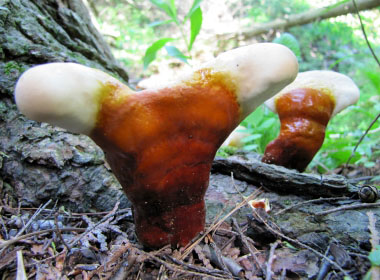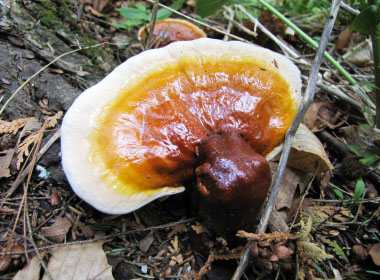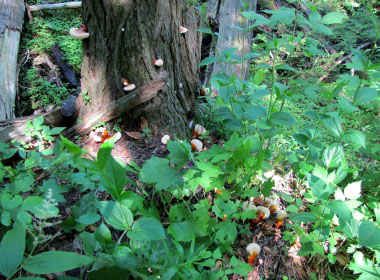






Do not eat any fungi that has not been properly identified by a qualified professional, some are DEADLY when ingested. All edible wild fungi MUST be cooked.
Reishi is a parasitic fungi that occurs on living conifers (especially eastern hemlock and western hemlocks) and saprobic on the deadwood of conifers. Ganoderma means having a shinyor lustrous skin; tsugae means hemlock (Tsuga). Ganoderma tsugae is closely related to Ganoderma lucidum and the two are virtually indistinguishable from one another on the basis of physical features alone. However, Ganoderma tsugae is partial to conifers, especially hemlocks and firs; Ganoderma lucidum is found on the wood of hardwoods.
Type
Distinguishing Features
Reishi has a bright, white, outer growth margin while growing. As growth continues, the margin may begin to change colour and develop a tough skin that has a shiny lacquered appearance. Ganoderma tsugae has whitish, rather than brownish flesh (Ganaderma lucidum is brownish). Both species are recognized by its shiny reddish to brownish-orange varnished cap and stem. It has a white margin; concentrially furrowed; surface becomes dull when coated by deposited spores. Caps measure 5 to 30 cm.
Height
Being a bracket fungi, reishi does not develop height. It's cap typically can reach cm in diametre. Reishi typically has a stem; 3 to14 cm long; up to 3 cm thick; it has a varnished appearance and coloured like the cap.
Habitat
Reishi grows on dead or dying eastern hemlock. It may also grow on other conifers beginning in late May or early June. It can continue to grow well into early autumn. One clue in locating an eastern hemlock tree is to see if any woodpeckers have been busy on the tree. Ganaderma tsugae will grow on the same tree for several years. Ganaderma lucidum grows in a similar fashion on hardwoods. They are widely distributed in North America where hemlocks occur, and occasionally reported from the Southwest U.S.
Spore Print
Brown spore print.
Season
Typically late summer into the autumn is when they reach full maturation. When a young specimen is found, it is good to know that it may take several weeks for the fruit to reach full size.
Gills
Not applicable. Spores are released through tiny pores on the underside of the mushroom rather than gills. Pore surface is whitish, becoming brown in age or when bruised; pores measure 4 to 6 per mm.
Edibility
This is not a fungi that can be eaten unless it is broken down then powdered. Then it can be used in a variety of meals, desserts and smoothies. Once broken into smaller pieces, it can be used to make tea.
Other Name
Lingzhi.
Recipes
A big thank you goes to my dear friend Colleen Wiebe for providing all the reishi images. Please subscribe to her nature videos at YouTube.
To support our efforts please browse our store (books with medicinal info, etc.).
Winter Survival Food Handbook

PDF Plant Magazines
Types of Wild Food
Geographic Zones Seasons
Disclaimer
EdibleWildFood.com is informational in nature. While we strive to be 100% accurate, it is solely up to the reader to ensure proper plant identification. Some wild plants are poisonous or can have serious adverse health effects.
We are not health professionals, medical doctors, nor are we nutritionists. It is up to the reader to verify nutritional information and health benefits with qualified professionals for all edible plants listed in this web site. Please click here for more information.
Why Edible Wild Food?
- Food costs are rising
- Free, wild food is readily abundant
- Wild food adds nutrition to your diet
- Wild food can help treat various medical conditions





